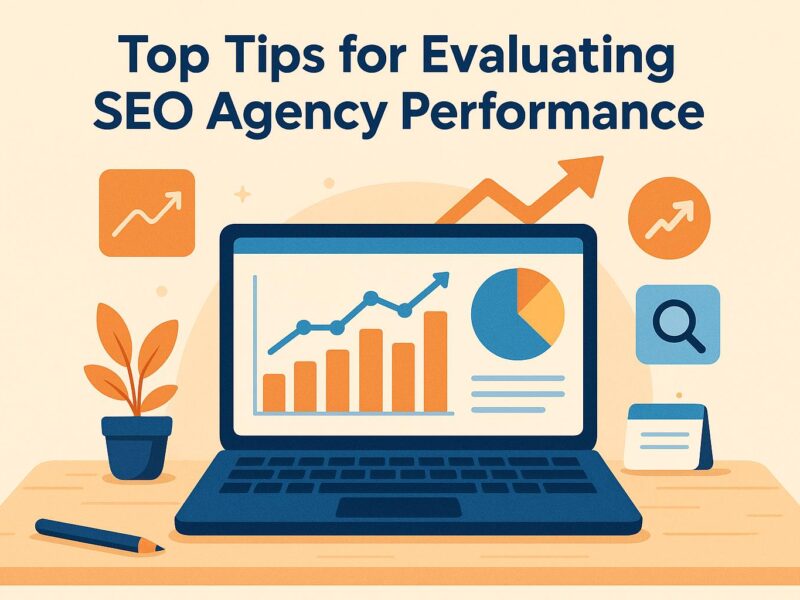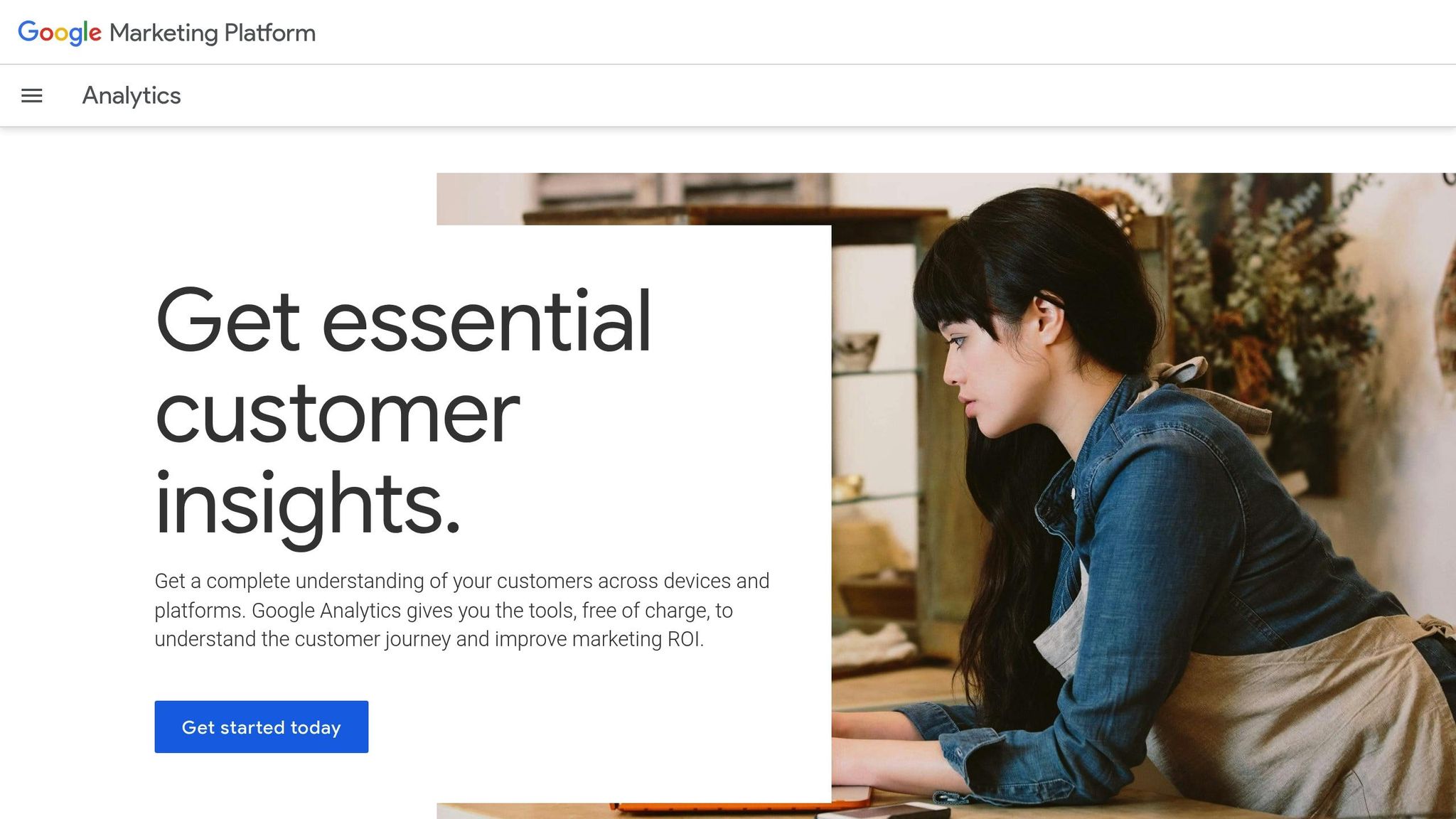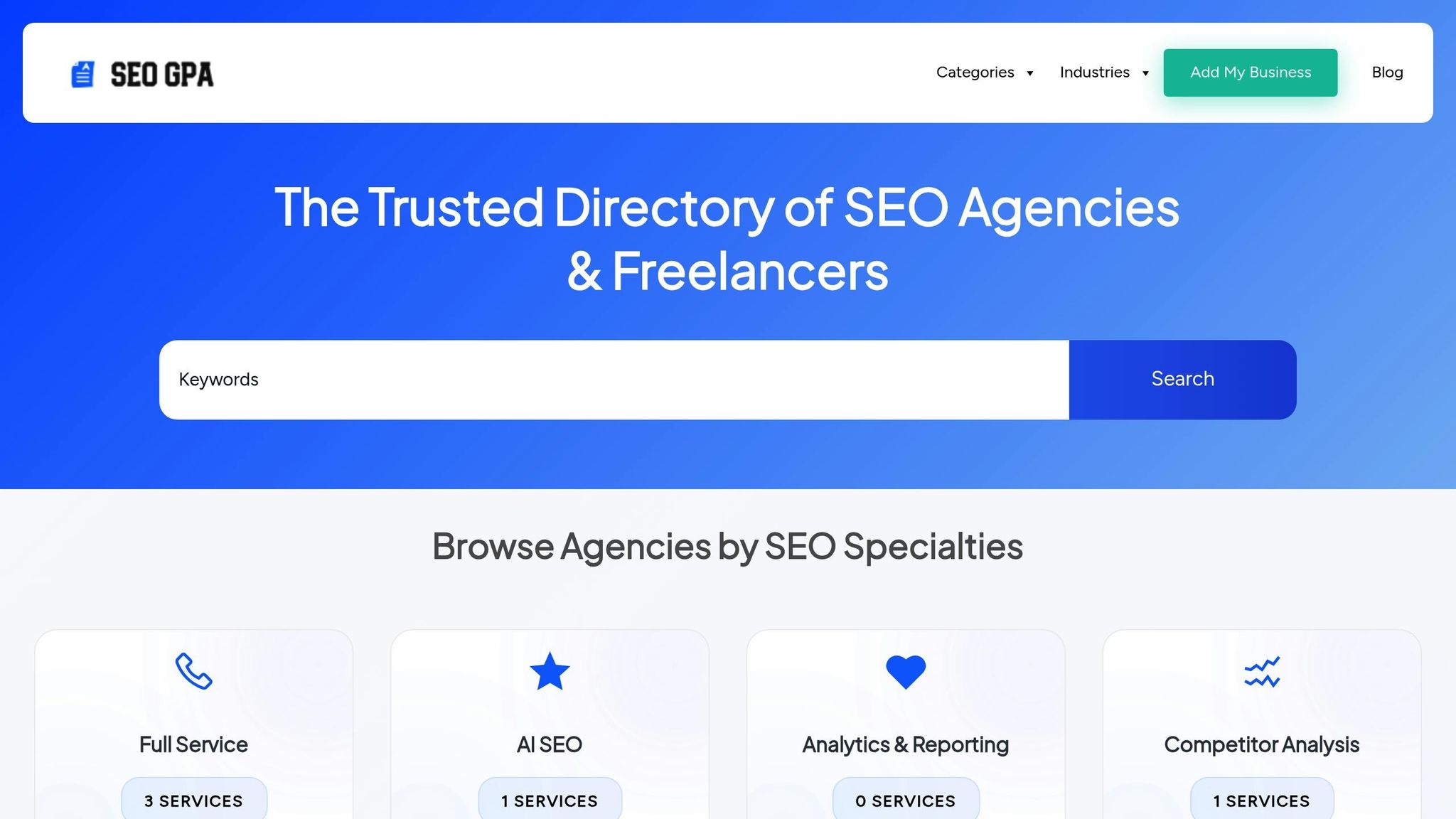
When hiring an SEO agency, the ultimate goal is measurable growth – more traffic, better rankings, and higher conversions. But how do you know if the agency is delivering? Here’s what you need to focus on:
- Track Key Metrics: Monitor organic traffic, keyword rankings, and conversion rates to gauge progress. Tools like Google Analytics and Ahrefs can help.
- Evaluate ROI: Compare revenue generated from organic traffic to your SEO spending. A simple formula: ROI = (Revenue – Investment) / Investment × 100.
- Assess Reporting: Look for clear, actionable reports that connect data to your business goals. Reports should include traffic sources, keyword trends, technical fixes, and competitor analysis.
- Check Alignment: Ensure the agency’s strategies support your specific goals, whether it’s e-commerce sales, lead generation, or local visibility.
- Review Communication: A good agency provides consistent updates, explains results, and offers solutions for challenges.
Key takeaway: Data-backed evaluations and clear reporting are essential to measure your SEO agency’s impact and ensure your investment drives real business results.
How Do I Evaluate An SEO Agency’s Proposal? – SearchEnginesHub.com
Key Performance Indicators (KPIs) to Track
Keeping an eye on the right metrics is essential to understanding if your SEO agency is driving meaningful results. These key performance indicators go beyond surface-level data, helping you focus on what truly supports your business growth.
Organic Search Traffic Growth
Organic traffic is the backbone of SEO success. It reflects how many visitors land on your site through unpaid search results. If your agency’s strategies are effective, you should notice a steady increase over time.
Tools like Google Analytics allow you to track organic traffic trends by comparing data month-over-month and year-over-year. Monthly comparisons help identify immediate changes, while yearly data accounts for seasonal variations.
Don’t stop at traffic numbers – dig into engagement metrics like session duration, pages per session, and bounce rate. These can highlight whether your content is resonating with your audience or if there are targeting issues to address.
Keep in mind that organic traffic growth is usually a slow build. Significant improvements often take 6 to 12 months of consistent effort. Sudden spikes or drops might signal algorithm updates or technical problems that need quick action.
Keyword Ranking Improvements
Keyword rankings are a direct indicator of how well your SEO efforts are performing for the search terms your audience is using. They show whether your agency’s optimization strategies are helping you climb closer to the top of search results. Tracking these rankings not only improves your visibility but also helps you understand your audience better and refine your approach.
Focus on monitoring your most critical keywords – those that align closely with your business goals. Tools like Ahrefs or SEO GPA can automate this process, making it easy to track progress over time. Instead of spreading your attention across hundreds of terms, hone in on 20 to 30 key phrases that truly matter to your goals.
Long-tail keywords can often be more effective than broad, highly competitive terms. These specific phrases tend to have higher click-through rates and less competition, which means better rankings and conversions. Keep in mind that keyword rankings naturally fluctuate, so don’t panic over small changes.
While rankings are important, they’re only part of the story. The ultimate goal is to drive conversions.
Conversion Rate from Organic Traffic
Beyond traffic and rankings, conversion rate measures how well your organic visitors are taking meaningful actions – whether that’s making a purchase, filling out a form, or subscribing to your newsletter.
To calculate your conversion rate, divide the number of conversions by the total number of organic visitors. For example, 50 conversions from 1,000 visitors would equal a 5% conversion rate.
It’s helpful to track both macro-conversions (like sales or lead generation) and micro-conversions (like email signups or content downloads). Both types provide valuable insights into how your SEO efforts are progressing.
Your SEO agency should aim to drive not just traffic, but high-quality traffic that converts. This might mean targeting keywords with commercial intent, optimizing page load speeds, or crafting content that directly addresses user needs. Research suggests that content ranking in the top 10 search results often averages around 1,890 words, but remember – quality and relevance matter far more than word count.
Finally, compare your organic conversion rates to those from other traffic sources. If organic visitors are converting at a significantly higher or lower rate than those from paid ads or social media, it could reveal important insights about the quality of traffic your SEO strategy is bringing in.
How to Evaluate Reporting Practices
The quality of an SEO agency’s reporting can tell you a lot about their expertise and commitment. A well-crafted report doesn’t just throw numbers at you – it connects the dots between data, insights, and actionable recommendations, showing how well the agency understands your goals. These reports should align with the KPIs we discussed earlier, giving you a clear picture of your SEO performance.
What Good SEO Reports Include
A solid SEO report breaks down your website’s performance in a way that’s easy to understand and actionable. Let’s look at the key elements:
- Traffic data: This is the backbone of any report. It should go beyond visitor numbers to show where your traffic comes from, which pages are performing well, and how user behavior evolves over time.
- Ranking updates: These are essential. Reports should highlight your current keyword rankings, track changes over time, and explain why shifts occurred. A good agency won’t just hand you numbers – they’ll provide context about what those shifts mean for your business.
- Technical health assessments: These reports should flag issues like crawl errors, slow-loading pages, mobile usability problems, and broken links. These technical factors directly influence how search engines view your site and can make or break your rankings.
- Competitive analysis: Understanding where you stand in your industry is crucial. Reports should compare your performance to competitors, pinpoint areas where you’re lagging, and identify strengths you can capitalize on.
Finally, every report should end with clear, actionable recommendations. For example, instead of vague advice like "improve site speed", a good report might suggest, "Optimize product category pages for faster mobile loading times."
How Reports Should Match Business Goals
SEO reports should reflect what actually matters to your business, not just generic metrics. Tailored reports ensure that your SEO strategy aligns with your goals and delivers measurable outcomes.
For example:
- E-commerce businesses need reports that focus on revenue-driving keywords and the performance of product pages.
- Lead generation companies should see metrics centered on conversions and lead quality.
- Local businesses benefit from metrics like local search traffic and location-specific performance.
The frequency of reporting should also match your business’s needs. For instance:
- B2B companies with longer sales cycles may prefer detailed quarterly reports alongside monthly updates.
- Retail businesses might need weekly updates during busy seasons to make real-time adjustments.
Report Timing and Consistency
Consistency in reporting builds trust and ensures accountability. For most businesses, monthly reports strike the right balance – they provide enough data to identify trends without getting bogged down by daily fluctuations. Weekly reports can often be too noisy, while quarterly ones might not catch issues in time.
Agencies should deliver reports on a consistent schedule, paired with review meetings. These meetings allow for in-depth discussions about strategies and adjustments – something that can’t be achieved through an emailed report alone.
Good reports also provide historical context. Comparing current data to the past 3, 6, or 12 months helps you see whether changes are part of a larger trend or just short-term fluctuations.
Lastly, agencies should have protocols for emergency reporting. If there’s a major algorithm update, technical issue, or competitive shift, your agency should notify you immediately with an initial analysis and a plan of action. You should never be the one to discover a ranking drop on your own – the agency should always be ahead of the curve.
sbb-itb-36e0c40
How to Assess ROI and Business Impact
When it comes to SEO, tracking metrics like traffic and conversions is just the beginning. To truly measure success, you need to assess how these efforts contribute to your bottom line and align with your overall marketing strategy. This means going beyond rankings and traffic numbers to understand the financial impact of your SEO initiatives.
How to Calculate ROI from SEO Efforts
Calculating the return on investment (ROI) from SEO starts with connecting organic traffic revenue to your spending. The formula is simple: ROI = (Revenue from Organic Traffic – SEO Investment) / SEO Investment × 100.
To get started, use tools like Google Analytics or your e-commerce platform to track revenue from organic traffic. Multiply the conversion rate of organic visitors by your average order value or customer lifetime value. For example, if your organic traffic generates $50,000 in revenue and you’ve spent $8,000 on SEO, your monthly ROI would be 525%.
Don’t stop there – factor in Customer Acquisition Cost (CAC) for a more complete picture. Compare what it costs to gain customers through SEO versus other methods like paid ads or social media campaigns. If SEO-driven customers cost $25 to acquire while paid search customers cost $75, the advantage is clear and should be part of your evaluation.
For B2B businesses, lead quality matters as much as quantity. Leads generated through SEO often show higher intent and engage for longer periods than those from other channels. Track metrics like lead-to-customer conversion rates, sales cycle duration, and average deal size to see how organic leads compare to those from paid or referral sources.
Another key factor? SEO’s momentum builds over time. Unlike paid ads, which stop delivering results once the budget runs out, SEO continues to drive traffic and conversions long after the initial investment.
How SEO Works with Other Marketing Channels
SEO doesn’t operate in a vacuum – it can enhance the performance of your other marketing efforts. For example, the content created for SEO can also power email campaigns, social media posts, or even paid search ads.
Keyword research is particularly valuable here. It reveals what your audience is searching for, providing insights that can shape paid search strategies, content plans, and even product development. If your SEO agency’s keyword data helps reduce your paid ads’ cost-per-click by 30% while boosting conversions, that’s measurable value across channels.
You might also notice an increase in brand search volume as your SEO improves. When more people search specifically for your company name, it’s a sign of growing brand awareness that benefits all your marketing efforts. Keep an eye on branded search trends to see how your SEO work is influencing overall visibility.
For local businesses, SEO often drives offline actions like phone calls, store visits, or in-person consultations. While these may not always show up in digital analytics, they represent real, tangible business value.
How to Compare Organic Channel Performance
To understand whether your SEO investment is paying off, compare organic search performance against other traffic sources. Look beyond just traffic volume – examine metrics that reflect quality and business outcomes.
Start with conversion rates. Organic traffic often converts at higher rates than other channels, so document these differences regularly and calculate their revenue impact.
Engagement metrics are another key indicator. Organic visitors tend to spend more time on your site, view more pages, and bounce less often than visitors from paid or social channels. These behaviors suggest that SEO is attracting the right audience with stronger intent.
Customer lifetime value (CLV) is often higher for organic visitors. Since they find you through their own research, they’re more likely to be loyal, long-term customers. Track CLV over six to twelve months to see how organic traffic contributes to sustained growth.
Cost comparisons highlight SEO’s long-term benefits. While paid ads require ongoing spending to maintain traffic, SEO builds over time. Measure your cost per acquisition monthly, but also look at longer-term trends – over six months or a year – to see how SEO becomes more cost-effective as your rankings improve.
Finally, consider how organic traffic performs during seasonal shifts or economic downturns. Unlike paid channels, which can see sharp declines, organic search often remains steady, providing stability when you need it most.
When comparing channels, don’t forget about attribution complexity. Multi-touch attribution models can help you see how SEO supports conversions that might otherwise be credited to other channels. This ensures you’re giving SEO the credit it deserves for its role in the broader customer journey.
Tools and Resources to Support Evaluation
Once you’ve analyzed performance metrics and reporting practices, the next logical step is to use specialized tools to confirm your findings and uncover additional insights. These tools can help you validate results, monitor progress, and gain a clearer picture of your SEO performance.
Using Google Analytics for Performance Tracking

Google Analytics is a go-to platform for tracking organic traffic, user engagement, and conversions. By creating custom segments, you can focus specifically on organic traffic and evaluate key engagement metrics like session duration and bounce rate.
The Goal Conversions feature is particularly useful for measuring actions that matter most to your business, such as form submissions, phone calls, or online purchases. Navigate to Conversions > Goals > Overview and filter by organic search to determine your conversion rate and revenue per session.
If you’re running an e-commerce site, Enhanced E-commerce tracking can link specific keywords and landing pages directly to revenue data.
Another essential feature is the Search Console integration within Google Analytics. This integration provides data on which queries bring users to your site and how your click-through rates evolve over time. If your agency claims to be improving rankings but you’re not seeing more clicks from relevant searches, it’s a red flag worth investigating.
Keyword Tracking with Ahrefs or Similar Tools

While Google Analytics gives you a view of traffic and engagement, keyword tracking tools like Ahrefs shine a light on the search engine rankings that drive those results. These tools allow you to monitor the positions of your target keywords over time.
The Organic Keywords report in Ahrefs shows which search terms bring traffic to your site and their estimated search volumes. Compare this data to your agency’s keyword targets to ensure they’re focusing on the terms that align with your business goals. Sometimes agencies prioritize high-volume keywords that don’t convert, while neglecting lower-volume terms that bring in qualified leads.
You can also track competitor rankings to assess the effectiveness of your strategy. Content gap analysis is another powerful feature – it identifies keywords your competitors are targeting that you haven’t yet captured. If your agency isn’t regularly presenting new keyword opportunities based on competitor research, they may be overlooking growth potential.
Ahrefs’ Site Audit tool is invaluable for identifying technical SEO issues that may be affecting your site’s performance. Running these audits monthly and sharing the results with your agency can reveal how quickly and effectively they address technical problems – a key indicator of their expertise.
Using SEO GPA for Agency Insights

SEO GPA is a comprehensive platform designed to help you evaluate SEO agencies and benchmark your current provider’s performance. It organizes agencies by service type, industry focus, and business size, making it easier to find one that matches your specific needs.
Agency profiles include details like team size, areas of expertise, and experience. Client reviews and performance analytics provide insights you won’t find on agency websites. Real-world feedback from other businesses can reveal how agencies handle communication, meet deadlines, and deliver results. Look for recurring themes in reviews – whether positive or negative – to get a clearer picture of an agency’s strengths and weaknesses.
The platform’s smart filtering system allows you to narrow down options based on factors like budget, location, and the services you require. For instance, if you’re looking for technical SEO or content marketing expertise, you can filter for agencies that specialize in these areas.
Verified expertise indicators help distinguish credible agencies from those making exaggerated claims. SEO GPA’s verification process ensures listed agencies have proven experience and can back up their capabilities with real results.
Additionally, the platform offers resources and guides to help you ask the right questions and set realistic expectations. By understanding SEO best practices, you become a more informed client and can quickly spot when an agency is cutting corners or using outdated methods.
Making Data-Driven Decisions
When it comes to evaluating your SEO agency’s performance, relying on hard data and measurable outcomes is the way to go. Gut feelings might work in some areas of life, but when it comes to SEO, numbers tell the real story.
Key Evaluation Criteria Summary
As mentioned earlier, the core metrics to focus on are organic traffic, keyword rankings, and conversions. These metrics form the foundation for assessing an agency’s impact. But remember, not all traffic is created equal – conversion rates often paint a clearer picture of effectiveness.
For example, an agency driving 10,000 monthly visitors with a 0.5% conversion rate doesn’t add as much value as one delivering 5,000 visitors with a 2% conversion rate. Why? Because the latter demonstrates better efficiency in turning visitors into customers.
A quality agency will go beyond surface-level numbers. Their reports should clearly connect SEO activities to your business outcomes. They’ll show which content is driving conversions and highlight the keyword opportunities they’re working on. If their reports are heavy on vanity metrics – like page views – but light on actionable insights, that’s a red flag.
To truly understand the ROI of your SEO investment, compare your revenue against what you’re spending. Tools like Google Analytics and Ahrefs can help verify these numbers. While SEO typically delivers positive ROI within 6 to 12 months, industries with stiff competition may require more time to see results.
In short, these metrics don’t just measure performance – they help you find an agency that consistently delivers results for your business.
Why You Need a Trusted SEO Partner
SEO isn’t a one-and-done effort; it’s a long-term game. That’s why having a reliable SEO partner who understands your business goals is so crucial. The right agency acts as an extension of your marketing team, offering insights that can shape broader business strategies.
A trustworthy agency doesn’t stick to a rigid plan – they adapt based on performance data. If certain keywords aren’t delivering results, they’ll shift focus to better opportunities. If technical issues crop up, they’ll address them promptly instead of waiting for scheduled meetings.
Clear communication is another hallmark of a good partner. Agencies that provide regular updates, respond quickly, and keep you in the loop tend to drive better outcomes. They know SEO works best when clients are informed and involved, not left on the sidelines.
Finding the right agency takes time, but platforms like SEO GPA make the process easier. With verified expertise indicators and client reviews, you can assess agencies based on actual results rather than flashy sales pitches. Real-world feedback and documented success stories give you the confidence to choose wisely.
Switching agencies isn’t just expensive – it can also derail progress. By thoroughly vetting potential partners upfront using data-driven criteria, you’ll avoid costly mistakes and set your business up for long-term success.
FAQs
How can I tell if my SEO agency’s strategies align with my business goals?
To determine whether your SEO agency’s strategies align with your business goals, the first step is ensuring they fully grasp your priorities. Are you aiming to boost organic traffic, climb the keyword rankings, or drive revenue growth? Whatever your focus, setting clear and measurable objectives from the start is essential to keep their efforts on track.
Regular communication is equally important. Insist on detailed performance reports that highlight key metrics like conversion rates, organic traffic trends, and ROI. These updates will give you a clear picture of progress and confirm whether their strategies are delivering the results your business needs.
What should I look for in an SEO report to ensure it provides meaningful insights?
An SEO report should do more than just dump a bunch of data – it should provide insights you can act on. Focus on key metrics like organic traffic trends, shifts in keyword rankings, conversion rates, backlink quality, and overall site health. These numbers tell you what’s working, what’s falling short, and how your SEO efforts are influencing your business outcomes.
A strong report doesn’t stop at showing progress; it also pinpoints areas where you can grow. For instance, tracking steady increases in organic traffic or seeing upward movement in critical keyword rankings can help shape your next steps. The best reports are straightforward, goal-oriented, and packed with the information you need to make confident, data-driven decisions.
How can I measure the ROI of my SEO efforts and evaluate their impact on my business?
To gauge the ROI of your SEO efforts and see how they’re impacting your business, keep an eye on essential metrics like organic traffic, keyword rankings, and conversions. Tools such as Google Analytics and Google Search Console can help you track these indicators with precision.
Calculating ROI is straightforward: compare the revenue driven by organic search to your SEO investment. For instance, if you’re spending $5,000 a month on SEO and it generates $20,000 in revenue, your ROI is 300%. Key metrics like conversion rates, organic traffic growth, and revenue from search reveal SEO’s role in your business performance.
By regularly analyzing these metrics, you’ll uncover what’s effective, enabling you to fine-tune your strategy and boost results over time.
Related Blog Posts
- SEO Agency Pricing: What Small Businesses Pay in 2025
- Red Flags When Hiring SEO Consultants: 8 Warning Signs
- SEO Agency Checklist: 15 Must-Have Qualifications
- Complete Guide to Vetting SEO Agencies
Comments